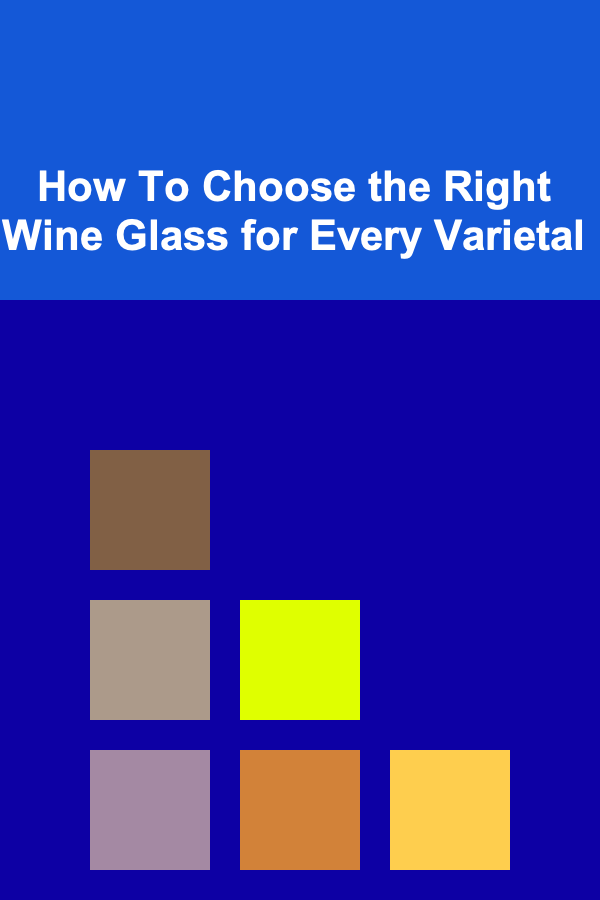
How To Choose the Right Wine Glass for Every Varietal
ebook include PDF & Audio bundle (Micro Guide)
$12.99$10.99
Limited Time Offer! Order within the next:

Choosing the right wine glass for each type of wine can seem like an unnecessary detail for casual drinkers, but for enthusiasts and connoisseurs, the right glass can elevate the tasting experience. A wine glass isn't just a vessel to hold your wine; it is a tool designed to enhance the flavor, aroma, and overall enjoyment of the wine. In this article, we will explore the importance of wine glasses, the science behind their design, and provide guidance on how to choose the right wine glass for different types of wine.
The Importance of a Wine Glass
Wine glasses are not created equal. Each type of glass is designed with specific characteristics intended to enhance the drinking experience. When you choose the appropriate glass, it helps concentrate the aromas, control the flow of the wine, and affect how the wine interacts with your palate. The shape, size, and material of the glass can influence how much oxygen comes in contact with the wine, how aromas are directed toward your nose, and how the wine moves across your tongue.
Factors That Affect the Wine Glass
There are several factors to consider when selecting the ideal wine glass:
- Shape: The bowl of the glass determines how aromas are concentrated. A larger bowl allows for more air to interact with the wine, which is important for wines that benefit from oxidation, such as red wines.
- Size: The size of the glass also plays a crucial role in the drinking experience. A larger glass allows more room for swirling, which helps release the aromas and enhances the wine's bouquet.
- Stem or Stemless: Wine glasses with stems are traditionally favored as they help prevent your hand from warming the wine. Stemless glasses, while more modern, can be suitable for casual drinking.
- Material: Most wine glasses are made from glass or crystal, with crystal being the preferred material for fine wine glasses due to its clarity and ability to highlight the wine's color. Some glasses are made of thinner materials that allow for more delicate aromas to be released.
- Rim: The rim of the glass should be thin and delicate. A thin rim ensures that the wine flows smoothly onto the palate, preventing the wine from spilling or flowing too quickly.
The Science Behind Wine Glasses
The design of wine glasses is rooted in science. Wine glasses are crafted with particular dimensions to affect how the wine interacts with oxygen, aromas, and the tongue. The surface area, for example, affects the speed at which the wine will oxidize. The right shape helps concentrate aromas toward the nose, allowing the drinker to fully experience the scent before taking a sip.
The Role of Oxygen in Wine Tasting
Oxidation plays a critical role in wine tasting. When wine is exposed to oxygen, chemical reactions occur that can bring out the flavors and aromas in the wine. However, too much exposure to oxygen can spoil the wine. Therefore, the shape of the glass helps manage the wine's interaction with oxygen. Glasses with wider bowls are typically used for wines that benefit from more oxidation, like red wines. Conversely, wines that are more delicate, such as white wines, are served in glasses that limit oxygen exposure.
Choosing the Right Glass for Red Wines
Red wines are among the most popular types of wine, and choosing the right glass is crucial to fully appreciating the complexity of red wines. Red wines generally require more room to "breathe" and benefit from oxidation, which helps release the deep, rich flavors.
Glass Shape and Size for Red Wines
Red wine glasses tend to have larger bowls than white wine glasses. This design allows for a greater surface area of the wine to come in contact with the air, promoting oxidation and enhancing the release of aromas. A larger glass also gives you more room to swirl the wine, allowing for better aeration.
Burgundy Glass: This type of glass has a wide bowl that is perfect for aromatic red wines, such as Pinot Noir and Burgundy. The shape allows for the wine's aromas to concentrate and the broader bowl lets the wine interact with oxygen.
Cabernet Sauvignon Glass: A taller and narrower glass is typically used for fuller-bodied wines like Cabernet Sauvignon and Bordeaux. The design directs the wine to the back of the mouth, allowing the wine's rich, tannic flavors to be enjoyed fully.
Merlot Glass: A medium-sized glass that is slightly more open than the Cabernet glass is ideal for Merlot and similar medium-bodied reds. It strikes a balance between focusing aromas and allowing oxidation, highlighting the smoothness and fruitiness of the wine.
Why Does the Shape Matter?
The reason red wines benefit from wider glasses is that these wines are often more complex, with multiple layers of flavors and aromas. The extra space in the glass allows the wine to interact with oxygen, which softens tannins and releases fruity, spicy, or earthy aromas.
Choosing the Right Glass for White Wines
White wines are generally more delicate and require a glass that preserves their crisp, fresh nature. White wine glasses tend to have a narrower bowl to restrict oxidation and maintain the freshness of the wine. The smaller surface area also concentrates the aromas, allowing for a more focused tasting experience.
Glass Shape and Size for White Wines
White wine glasses are typically smaller than red wine glasses. A narrower bowl minimizes the wine's contact with air, helping to preserve its crisp and refreshing qualities. White wine glasses also have a slightly smaller opening, which helps concentrate the aromas, leading to a more focused fragrance when the wine is swirled.
Chardonnay Glass: A glass with a slightly wider bowl is preferred for full-bodied white wines like Chardonnay. This shape allows the wine to breathe slightly while still maintaining its characteristic freshness. The shape is also perfect for highlighting the wine's rich aromas.
Sauvignon Blanc Glass: A narrower, taller glass is ideal for aromatic white wines like Sauvignon Blanc and Riesling. The smaller bowl focuses the wine's more delicate aromas and helps maintain its crisp acidity.
Pinot Grigio Glass: A simple and smaller glass is best suited for lighter white wines, such as Pinot Grigio. The narrow bowl enhances the wine's fresh, citrusy flavors and helps preserve its acidity.
Why Does the Shape Matter?
White wines are generally served cooler than reds, and their aromas are often more subtle. A narrower glass helps maintain the cool temperature of the wine and concentrates its delicate aromas. This is especially important for wines like Riesling or Sauvignon Blanc, which are prized for their fresh, fragrant profiles.
Choosing the Right Glass for Sparkling Wines
Sparkling wines, such as Champagne and Prosecco, require a unique glass because of their effervescence. The goal is to preserve the bubbles and highlight the wine's crisp, refreshing qualities.
Glass Shape and Size for Sparkling Wines
The traditional flute glass has long been associated with sparkling wines. This tall, narrow glass is designed to preserve the bubbles by limiting the surface area through which the wine is exposed to air. The narrow shape also focuses the aromas and directs them toward the nose.
Champagne Flute: The classic Champagne flute has a tall, slender design that allows the bubbles to travel upward and preserves the effervescence. The narrow opening also concentrates the aromas, enhancing the wine's fresh and crisp profile.
Tulip Glass: The tulip-shaped glass is another option for sparkling wines. It has a wider base and narrower opening, which allows for better aeration while still preserving the bubbles. This glass shape is especially good for higher-quality sparkling wines that benefit from a bit of air exposure.
Why Does the Shape Matter?
The shape of the glass plays an essential role in preserving the bubbles in sparkling wines. The flute design limits the surface area, preventing the rapid dissipation of carbon dioxide and helping the bubbles last longer. Additionally, the narrow opening directs the wine's aromas toward the nose, enhancing the sensory experience.
Choosing the Right Glass for Dessert Wines
Dessert wines, such as Sauternes or Port, are rich and flavorful, often served in smaller quantities due to their sweetness and intensity. These wines require glasses that complement their strong, concentrated flavors.
Glass Shape and Size for Dessert Wines
Dessert wine glasses are generally smaller than those used for red or white wines. The smaller size helps concentrate the aromas and flavors, ensuring that the wine's richness is fully experienced without being overwhelming.
Port Glass: A small glass with a short bowl is often used for Port and other fortified wines. The shape helps concentrate the wine's rich, sweet aromas while ensuring that the wine is enjoyed in smaller sips.
Sauternes Glass: For sweet wines like Sauternes, a slightly narrower glass is ideal. The smaller bowl allows the wine to interact with oxygen just enough to release its complex aromas, while the smaller size helps focus the sweetness and richness of the wine.
Why Does the Shape Matter?
Dessert wines are more concentrated than other wines, and their aromas are often quite intense. A smaller glass helps balance the richness, concentrating the aromas and allowing the wine to be enjoyed in small, controlled sips.
Conclusion
The right wine glass plays a pivotal role in enhancing your wine experience. Whether you are enjoying a delicate white wine, a full-bodied red, a bubbly Champagne, or a sweet dessert wine, selecting the appropriate glass helps bring out the best in the wine. By understanding the science behind the design of wine glasses and how each type of glass interacts with different varietals, you can make an informed choice and elevate your wine-tasting experience to new heights.
Other Products

How to Create a Party Supplies Checklist for Barbecues and Cookouts
Read More
How to Curate a Family Gallery of Artworks and Crafts
Read More
How to Get ChatGPT to Generate Educational Course Outlines
Read More
How to Make Money Online as a Language Tutor
Read More
How to Make Your Money Work for You Through Smart Investing
Read More